Page 3 of 22
Re: CRINCH! The Crab of the Day!
Posted: Sun Dec 06, 2015 6:46 pm
by Nezumiiro
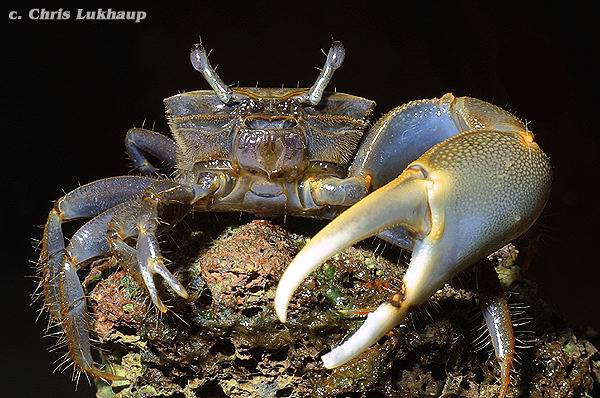 CRINCH! #CrabOfTheDay for 12/06/2015:
CRINCH! #CrabOfTheDay for 12/06/2015: Mudflat Fiddler Crab or Uca rapax is a wild-lookin’ crab from the Western Atlantic, West Indies & the Caribbean. This fiddler is one of approximately 97 species belonging to the family Ocypodidae, a group characterized by a square body, herding behavior, and MASSIVE BEEFY CLAWS on males.
Having such a massive claw can come at a massive cost. The male’s large claw is so unwieldy and specialized; it cannot be used for eating or digging. Thus the males have to work harder than the females at hunting and shelter building. In strange biological kismet, If a male loses its big claw, the small, remaining claw will grow to become the big claw, and the baby newly grown claw will become the feeding claw.
U. rapax is particularly important for the mudflats and marshes they inhabit. When Mudflat fiddlers burrow in the salt marsh, they expose the deeper soils to air, helping many varieties of marsh plant grow.
https://en.wikipedia.org/wiki/Fiddler_crabhttp://www.marinespecies.org/aphia.php? ... &id=378379
Re: CRINCH! The Crab of the Day!
Posted: Sun Dec 06, 2015 6:48 pm
by Nezumiiro
 CRINCH! #CrabOfTheDay for 12/07/2015:
CRINCH! #CrabOfTheDay for 12/07/2015: Mithrax pleuracanthus aka The Shaggy Clinging Crab is a close cousin to Western Atlantic Majidae interim spider crabs such as modern decorator crabs. This species
This Mithrax is pretty small, sporting an average carapace length of ONLY 3.6 cm. ALL genus Mithrax crabs share certain characteristics such as “spoon-shaped” claw tips, legs armed with spines and anchor hairs, and a carapace with two prominent rostral horns.
Shaggy Clingers get their name for their proclivity for grasping on moving things such as swaying seaweed, floating debris, and even boats.
M. pleuracanthus shows direct lineage to a fossil species, Damithrax cf. pleuracanthus- first recognized in the fossil record during the late Pliocene–early Pleistocene epoch.
http://www.marinespecies.org/aphia.php? ... &id=454040http://eol.org/pages/342162/overview
Re: CRINCH! The Crab of the Day!
Posted: Mon Dec 07, 2015 11:59 pm
by Nezumiiro
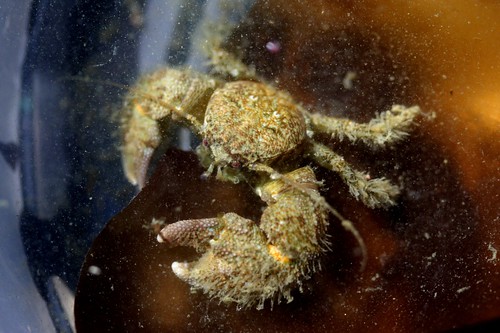 CRINCH! #CrabOfTheDay for 12/08/2015:
CRINCH! #CrabOfTheDay for 12/08/2015: Pachycheles monilifer or The Wormreef Porcelain Crab is a particularly rare crab native the middle and Western Atlantic Ocean littoral and (though only occasionally) deepwater reefs. This knobby armed beastie and its brethren differ from true (brachyuran) crabs in that the possess ‘uropods’ (specialized swimming paddle-legs) like lobsters and their diminutive last-row walking legs are dorsally directed.
The Wormreef Porcelain Crab is named for the EPIC Brawls it pick with the bristleworms it eats, which also live in the same sabellariid worm reefs, most noteworthy off the coast of São Paulo, Brazil.
http://www.marinespecies.org/aphia.php? ... &id=421868http://www.boldsystems.org/index.php/Ta ... xid=149520
Re: CRINCH! The Crab of the Day!
Posted: Wed Dec 09, 2015 1:17 am
by Nezumiiro
 CRINCH! #CrabOfTheDay for 12/09/2015:
CRINCH! #CrabOfTheDay for 12/09/2015: The Panther Crab (Parathelphusa pantherina) is a ‘fully aquatic’ meaning, ‘lives fine in a freshwater tank’ crab native to Indonesia and parts of Southeast Asia. This is one of the very few types of freshwater aquarium crabs that can live fully immersed in water at all times, with no land area required. These beautifully speckled crabs tend to be friendly with their own AND other, similar species and may be kept in medium sized groups. They are very easy to care for and seem to be relatively hardy.
Unfortunately, P. pantherina, is a threatened species- rated “vulnerable” to a high risk of extinction in the wild due to its native habitat being altered by mining pollution and introduction of non-native species.
http://www.iucnredlist.org/details/134415/0http://www.inaturalist.org/taxa/108712- ... pantherina
Re: CRINCH! The Crab of the Day!
Posted: Wed Dec 09, 2015 2:01 am
by Mutt12
Nezumiiro wrote: CRINCH! #CrabOfTheDay for 12/09/2015:
CRINCH! #CrabOfTheDay for 12/09/2015: The Panther Crab (Parathelphusa pantherina) is a ‘fully aquatic’ meaning, ‘lives fine in a freshwater tank’ crab native to Indonesia and parts of Southeast Asia. This is one of the very few types of freshwater aquarium crabs that can live fully immersed in water at all times, with no land area required. These beautifully speckled crabs tend to be friendly with their own AND other, similar species and may be kept in medium sized groups. They are very easy to care for and seem to be relatively hardy.
Unfortunately, P. pantherina, is a threatened species- rated “vulnerable” to a high risk of extinction in the wild due to its native habitat being altered by mining pollution and introduction of non-native species.
http://www.iucnredlist.org/details/134415/0http://www.inaturalist.org/taxa/108712- ... pantherina
OMG I so want an aquarium crab again. I'm kinda afraid to though because I had a couple red-claw crabs a few years ago that seemed happy for a good year or so before succumbing to the mysterious "creeping death".
Re: CRINCH! The Crab of the Day!
Posted: Wed Dec 09, 2015 9:00 pm
by Nezumiiro
 CRINCH! #CrabOfTheDay for 12/10/2015:
CRINCH! #CrabOfTheDay for 12/10/2015: Uca maracoani or The Brazilian Fiddler Crab is an EXTREME example of the sexual dimorphism that Malacostraca fiddler crabs are known for. Native to tidal mangroves in the Southwest (below the equator) Atlantic, Brazilian Fiddler males are blessed/burdened with the biggest, scary ‘hornbill’ claw that I could imagine! Take a look at some of the extra pics or that video- it’s MASSIVE!
First observed during the 1802 Pierre André Latreille study, males use their monster appendages more for waving (mating/competition display) than for combat. That said, Beefcake here can and will pinch the ever living crap outta anything it gets its claw into.
http://eol.org/pages/128594/overviewhttp://www.marinespecies.org/aphia.php? ... &id=378412
Just check out this GUNSHOW!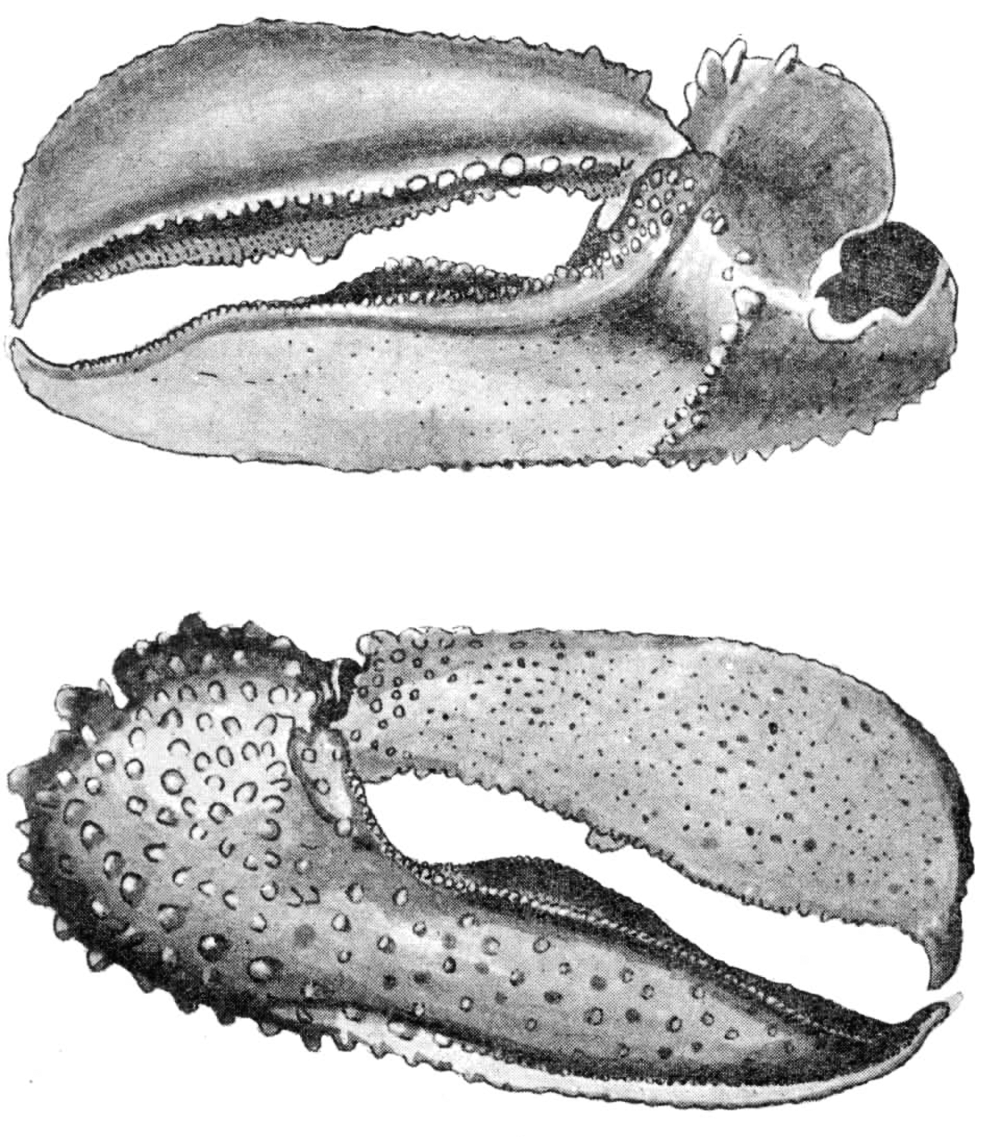
Re: CRINCH! The Crab of the Day!
Posted: Fri Dec 11, 2015 3:28 am
by Nezumiiro
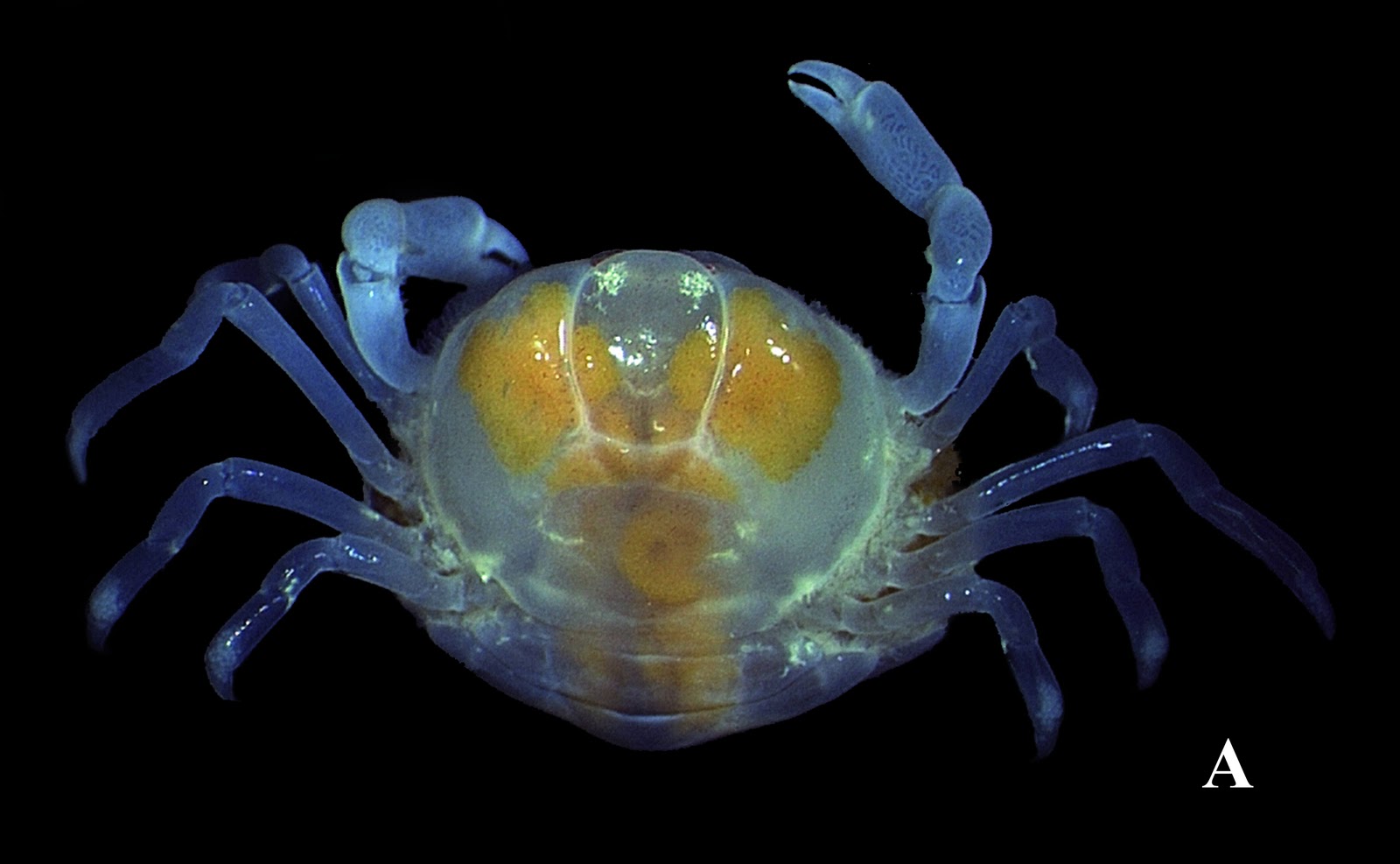 CRINCH! #CrabOfTheDay for 12/11/2015:
CRINCH! #CrabOfTheDay for 12/11/2015: Fabia byssomiae, an unnamed Pea Crab cataloged by Thomas Say during an 1818 geological expedition to the off-shore islands of Georgia and Florida, then Spanish territory. This tiny pinnotheridae semi-parasite lives within the mantle cavity of Western Atlantic bivalves, most commonly, those from the genera Glycymeris and Anadara, including the Constricted Macoma Clam. (Macoma constricta)
Although pea crabs are kleptoparasites, (food stealers!) their presence doesn’t seem to increase oyster mortality. Aside from some light gill damage, an oyster can grow healthily while hosting a pea crab, but its health can be impacted when there is less food in the water as the pea crab will feed on the filtered food first.
Fanfact: If you order clams or mussels and find a pea crab in your meal, NO WORRIES! They’re safe to eat, and their relatively sweeter taste makes them an interesting flavor/visual addition! In some (mostly Euro) restaurants, ALL the clams will have a pea crab inside!
http://www.marinespecies.org/aphia.php? ... &id=422154http://www.itis.gov/servlet/SingleRpt/S ... alue=98989
Re: CRINCH! The Crab of the Day!
Posted: Fri Dec 11, 2015 11:58 pm
by Nezumiiro
 CRINCH! #CrabOfTheDay for 12/12/2015:
CRINCH! #CrabOfTheDay for 12/12/2015: Speloeophorus nodosus or The Twohole Clutch Crab is a small leucosiidae crab occidental to North and South Carolina, Florida, the Gulf of Mexico, the West Indies, and Brazil. This little guy’s entire genus is relatively rare; up to date, only eight known Speloeophorus species exist, two of them occurring ONLY in the Brazilian coast.
While Leucosiidae crabs are called “Purse Crabs,” their much-tinier subgenera cousins, the Speloeophorus crabs are called “Clutch Crabs.” Get it?
http://www.itis.gov/servlet/SingleRpt/S ... alue=98386http://www.marinespecies.org/aphia.php? ... &id=421937
Re: CRINCH! The Crab of the Day!
Posted: Sun Dec 13, 2015 12:52 am
by Nezumiiro
 CRINCH! #CrabOfTheDay for 12/13/2015:
CRINCH! #CrabOfTheDay for 12/13/2015: Romaleon polyodon or the Chilean Hairy Crab is a South Pacific Stone Crab, who like the other members of the marine crab genus Romaleon, was formerly considered in the genus Cancer. Chilean 'Stoners' are highly aggressive predatory Brachyura crabs who can actually reduce overall biodiversity in a hunting field.
Aside from the hairiness on R. polyodon’s shell and walking legs, these guys have a carapace with nine well-defined teeth on each side and bright red eyes.
http://www.marinespecies.org/aphia.php? ... &id=440403https://en.wikipedia.org/wiki/Romaleonhttps://vimeo.com/54564803
Re: CRINCH! The Crab of the Day!
Posted: Mon Dec 14, 2015 1:26 am
by Nezumiiro
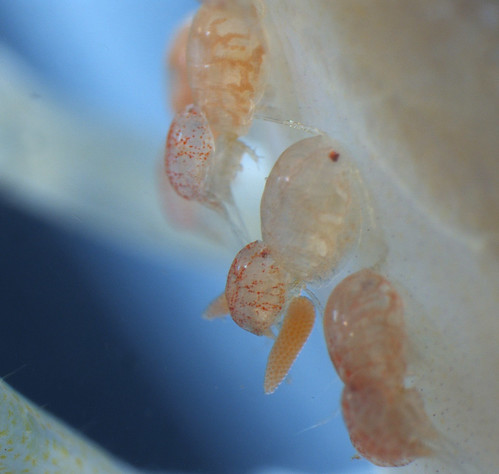 CRINCH! #CrabOfTheDay for 12/14/2015:
CRINCH! #CrabOfTheDay for 12/14/2015: The Snapping Shrimp Symbiotic poecilostomatoid copepod or Anthessius alpheusicolous isn’t actually a crab- rather it’s a tiny parasitic crustacean with specialized claws, "oar-feet" and mouthparts. These tiny holoplankton animals (meaning they stay planktonic for all of their lifecycle) LIVE attached to crabs, lobsters, and shrimp. Most parasitic species of copepod simply feed on their host’s blood and digestive capabilities, but many, such as A. alpheusicolous have a symbiotic relationship with their larger crustacean cousins; aiding in gas exchange, cleaning, or keeping smaller more dangerous parasites from gaining a foothold.
Because of their small size, most copepods have a single compound eye in the middle of their head, AND no need of any heart or circulatory system. Most also lack gills. Instead, they absorb oxygen directly into their bodies from the water.
http://www.marinespecies.org/aphia.php? ... &id=608072https://en.wikipedia.org/wiki/Copepod
Re: CRINCH! The Crab of the Day!
Posted: Mon Dec 14, 2015 9:36 pm
by Nezumiiro
 CRINCH! #CrabOfTheDay for 12/15/2015:
CRINCH! #CrabOfTheDay for 12/15/2015: Epialtus bituberculatus or the Variegate Spider Crab is one of the most diminutive Brachyuran members of Epialtinae. Native to the Gulf of Mexico and Southwestern Atlantic, oddly enough this crab is most commonly observed in former French colonies. This context is indicated in the crab’s prior name: Epialtus affinis, as “affinis” is the Latin/French word meaning “affinity to, but is not identical to.” (In regards to cataloging species’)
Seldom reaching above 1cm in width, Variegate Spiders spend a fair chunk of their life as zooplankton, before settling into adult domicile in reefs and Sargassum beds. The specialized pinchers these guys have lets them grasp onto and comfortably maneuver on swaying seaweed, allowing them to resist even the strongest wave impact.
http://www.marinespecies.org/aphia.php? ... &id=421941http://www.itis.gov/servlet/SingleRpt/S ... alue=98448
Re: CRINCH! The Crab of the Day!
Posted: Tue Dec 15, 2015 8:54 pm
by Nezumiiro
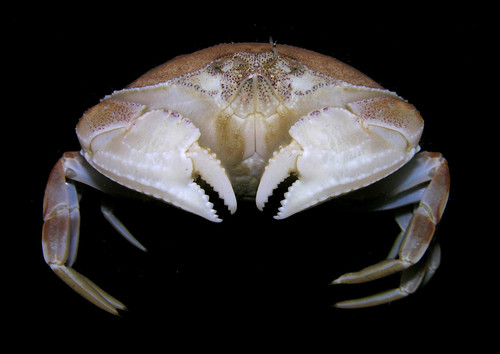
CRINCH! #CrabOfTheDay for 12/16/2015: The Flecked Box Crab (Hepatus pudibundus) Is a busy-patterned Box Crab found in the Gulf of Mexico, Central, and South America. This beautiful beastie, like many of the region’s Box Crabs, has those gnarly-looking downward facing claws (they’re pretty much upside down!) perfectly specialized for snatching things off of the surface sandy and muddy substrates where they live. H. pudibundus can effectively ‘fold up’ as unlike standard crabs, Box Crabs have a body morphology designed for this, helping them avoid predation by tucking everything in and burying themselves in the sand, with only their eyes exposed.
In a fun homonym twist, Female box crabs that are bearing eggs are said to be "berried."
http://www.marinespecies.org/aphia.php? ... &id=344730http://www.itis.gov/servlet/SingleRpt/S ... alue=98349
Re: CRINCH! The Crab of the Day!
Posted: Wed Dec 16, 2015 10:24 pm
by Nezumiiro
 CRINCH! #CrabOfTheDay for 12/17/2015:
CRINCH! #CrabOfTheDay for 12/17/2015: The Velvet Swimming Crab, aka Necora puber (formerly Polybius puber) is a black and white variegate crab, covered with a velvety pile. This striped beastie is found in British coastal waters, and is the largest European swimming crab, widely farmed in UK fisheries. The Velvet Swimming Crab lives from southern Norway to Western Sahara in the North Sea and north Atlantic as well as western parts of the Mediterranean Sea, on rocky bottoms from the shoreline to a depth of about 65 meters. Like all swimming crabs, the last pair of N. puber’s pereiopods (walking legs) is flattened to facilitate swimming.
This fast-moving crab is fairly notable for its bright red eyes. The color of these eyes and the general aggressive nature of this species may explain the alternative names of ‘Devil Crab’ and ‘Black Witch Crab.’ Velvet Swimming Crabs are traditionally consumed by southern European nations such as France and Spain. A sudden decline in fisheries in the 1980s due to over-exploitation and disease led to the commercial development of the fishery in the UK and Ireland.
http://www.sealifebase.org/summary/Necora-puber.htmlhttps://en.wikipedia.org/wiki/Velvet_crab
Re: CRINCH! The Crab of the Day!
Posted: Thu Dec 17, 2015 8:47 pm
by Nezumiiro
 CRINCH! #CrabOfTheDay for 12/18/2015:
CRINCH! #CrabOfTheDay for 12/18/2015: The Atlantic Ghost Crab (Ocypode quadrata) is a small, beach-borne burrowing crab that like other Ocypode ‘ghost crabs,’ has VERY distinct eyestalks. O. quadrata creates its tunnels above the intertidal zone on Atlantic coasts from Delaware through the Caribbean and Gulf of Mexico to Brazil. These hyperactive cousins to fiddler crabs can often be seen dashing into the retreating surf to wet their gills or to grab scraps of food. ("Ocypode" means "swift-footed") The semi-terrestrial Atlantic Ghost Crab requires an ocean-adjacent habitat for feeding, breathing, and breeding, yet will drown if kept submerged.
During winter, Atlantic Ghosts "hibernate" during the winter in some incredible sleeping burrows which can be up to four feet deep, and are often found hundreds of feet from the water's edge.
Even more amazing- Most species of Ghost Crabs have a specialized (albeit limited) form of communication involving three sounds: striking the ground with their claws, rubbing their legs together or making a bubbling sound.
http://www.itis.gov/servlet/SingleRpt/S ... alue=99082https://en.wikipedia.org/wiki/Atlantic_ghost_crab
Re: CRINCH! The Crab of the Day!
Posted: Fri Dec 18, 2015 10:30 pm
by Nezumiiro

CRINCH! #CrabOfTheDay for 12/19/2015: The Giant Hermit Crab or Petrochirus Diogenes is a MASSIVE Caribbean and Atlantic hermit that inhabits only the largest of gastropod shells, such as the shell of a fully grown Lobatus gigas, or Queen Conch. This mighty Diogenidae family crab does what not many other hermits do: it KILLS and EATS the original inhabitants of the shells it lives in!
If it weren’t for P. Diogenes’ massive size, it would still be very distinct with its broader than normal carapace, covered with setae, (tufts of hairs) distinct eyestalks, and wildly apparent ‘eyelashes.’
The specific Latin epithet “Diogenes “comes from Diogenes of Sinope, the famed Greek philosopher and founder of Cynic philosophy.
https://en.wikipedia.org/wiki/Petrochirus_diogeneshttp://eol.org/pages/128501/overview
Re: CRINCH! The Crab of the Day!
Posted: Sun Dec 20, 2015 4:59 am
by Nezumiiro
 CRINCH! #CrabOfTheDay for 12/19/2015:
CRINCH! #CrabOfTheDay for 12/19/2015: Pinnixa littoralis or the Gaper Pea Crab is a tiny parasitic (rarely commensal) species, named for the fact that they primarily makes their living within the shells of larger bivalves, most notably the Pacific Fat Gaper Clam, Tresus capax. These GROSS family Pinnotheridae crabs also live inside tube worms, sea cucumbers, and other seafloor fauna.
Pea crabs are usually found in breeding pairs inside their host, where somehow the female will remain in the visceral fold, feeding directly on the material filtering in, while the males and juveniles roam around the mantle cavity. YUCK!
http://www.itis.gov/servlet/SingleRpt/S ... alue=98995http://www.centralcoastbiodiversity.org ... ralis.html
Re: CRINCH! The Crab of the Day!
Posted: Mon Dec 21, 2015 1:34 am
by Nezumiiro
 CRINCH! #CrabOfTheDay for 12/21/2015:
CRINCH! #CrabOfTheDay for 12/21/2015: The Nodose Clinging Crab or Mithraculus coryphe is NOT named for “No-Doz,” the popular caffeine pills. This tiny reef crab is at home in the Gulf of Mexico, Western Atlantic, and most prominently, the Caribbean islands, and seldom reaches more than one inch across in size. Common on shallow reefs and coral rubbles, occasionally the “Nodose” will hitchhike to non-native reefs, causing damage to both soft and stony corals by opening up crevices/tears in their skin tissue and feeding on the mucus discharged from the wound. When they make their way (accidentally!) into aquariums, owners take GREAT care to remove them upon sight.
A common denominator for all species of clinging crabs is the blunted tips of the claws that fit together like small rows of teeth. These claws are typically used to scrape algae and other bits off the rocks and reefs where they are found.
https://www.idigbio.org/portal/records/ ... 755e343829http://www.marinespecies.org/aphia.php? ... &id=421987
Re: CRINCH! The Crab of the Day!
Posted: Tue Dec 22, 2015 9:51 pm
by Nezumiiro
 CRINCH! #CrabOfTheDay for 12/22/2015:
CRINCH! #CrabOfTheDay for 12/22/2015: Macrocoeloma trispinosum (nodipes), usually called The Spongy Decorator Crab, is the only Majidae species of decorator crab found primarily in Bermuda. Like other decorators, these abundant little guys camouflage themselves with organisms in their environment such as corals, anemones, sponges, and various algae. This behavior can have downsides however; TOO much decoration may heighten energy costs such as mobility, feeding, and escape strategies. The right coverings can provide alternative food sources, OR toxic protection from predators. (Some anemones and whatnot are poisonous!) Regardless of covering choice, these materials remain alive on the crab and are held in position by special velcro-like hairs called “setae.”
http://www.marinespecies.org/aphia.php? ... &id=421982http://eol.org/pages/1269673/overview
Re: CRINCH! The Crab of the Day!
Posted: Tue Dec 22, 2015 10:29 pm
by Nezumiiro
 CRINCH! #CrabOfTheDay for 12/23/2015:
CRINCH! #CrabOfTheDay for 12/23/2015: Huenia brevifrons, The Halimeda Algae Crab is a family Epialtidae species found in coral reefs and shallow bays with copious proximity to its preferred sea weed, Halimeda opuntia. Hailing from India, Philippines and Japan, this tiny green crab has a VERY distinct, irregular carapace shape (broader than longer) which enables Halimeda Crabs to better camouflage themselves among ocean greenery.
H. brevifrons has tiny little ambulatory legs, and sharply pointed pinchers, used for scissoring small chunks of plant matter off.
http://www.marinespecies.org/aphia.php? ... &id=441454http://www.sealifebase.org/summary/Huen ... frons.html
Re: CRINCH! The Crab of the Day!
Posted: Thu Dec 24, 2015 3:46 am
by Nezumiiro
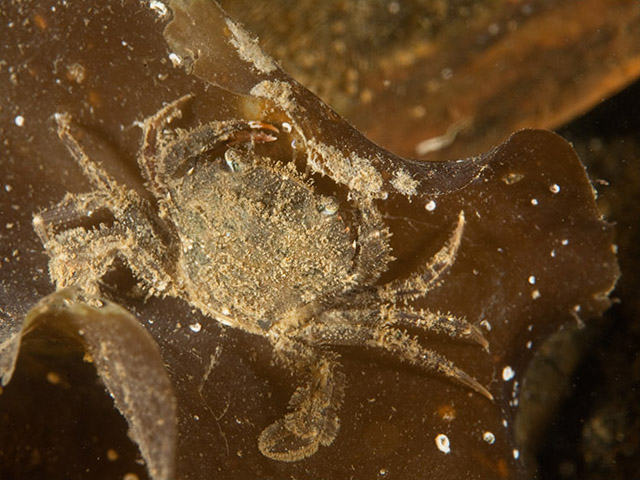 CRINCH! #CrabOfTheDay for 12/24/2015:
CRINCH! #CrabOfTheDay for 12/24/2015: The Arch-fronted Swimming Crab, Liocarcinus navigator, is a sub-littoral Portunidae species found on sand and gravel beds, among seagrass and algae. Named because its carapace is gently convex with small ridges, “Arch-fronts” are found chiefly around the British Isles from the north-east Atlantic Ocean, including the North Sea as far north as Trøndelag in Norway, and as far south as Mauritania and the Mediterranean Sea.
Two subspecies of L. navigator are recognized; Liocarcinus navigator rondeletii, and Liocarcinus navigator navigator.
http://www.marinespecies.org/aphia.php? ... &id=107392https://species.wikimedia.org/wiki/Lioc ... _navigator
Re: CRINCH! The Crab of the Day!
Posted: Fri Dec 25, 2015 5:27 am
by Nezumiiro
 CRINCH! #CrabOfTheDay for 12/25/2015:
CRINCH! #CrabOfTheDay for 12/25/2015: Percnon planissimum or The Flat Rock Crab is an appropriately brightly colorful species- perfect for bringing in the Christmas Cheer! This little guy forages among algae encrusted rocks and reefs in shallow water near or above the surface. Common in the Red Sea, India, the East Coast of Africa, Japan, and Hawaii, these crabs are extremely quick, moving so fast with their sideways motion they are often difficult to identify. Their speed and elusiveness make them unlikely photo subjects. When speed doesn’t work, Flat Rock Crabs have added protection in the form of short black bristles, three sharp anterolateral teeth, and on the front of their forearms and legs.
It’s theorized that their variegated blend of colors is TOO confusing for potential predators, in that the crab isn’t even immediately recognized as a foodsource. Ah, the old ‘Christmas Lights’ tactic!
And with that, y’all have a Pinchy CRINCHY Christmas! http://www.nio.org/userfiles/file/brach ... simum.htmlhttp://www.marinespecies.org/aphia.php? ... &id=207574
Re: CRINCH! The Crab of the Day!
Posted: Sat Dec 26, 2015 2:14 am
by Nezumiiro
 CRINCH! #CrabOfTheDay for 12/26/2015:
CRINCH! #CrabOfTheDay for 12/26/2015: Tetralia cavimana, The Brownish (Browny in the UK) Coral Crab is a Tetraliidae species first validly catalogued in 1861 by Czech marine zoologist, Camill Heller. These tiny, oddly-named reef-dwellers hail from The Red and Arabian Seas through Northeast Africa, India, Southeast Asia, Indonesia, Micronesia, Japan, and Australia. Named for their distinct yet varied ‘brownish’ coloration, T. cavimana crabs stay hidden in the branches of hard ‘Acropora’ corals, where the coral’s mucus layer traps delicious detritus. Unlike most other crabs, Brownies get along GREAT with the porcelain crabs with which they cohabitate.
Spelling similarities aside, Tetralia (Coral Crabs) and Trapezia (Guard Crabs) are not actually related, but are an example of convergent evolution in regards to their sustenance strategies and distinct claw morphology.
http://www.marinespecies.org/aphia.php? ... &id=443856http://species-identification.org/speci ... an&id=1481
Re: CRINCH! The Crab of the Day!
Posted: Sun Dec 27, 2015 2:09 am
by Nezumiiro
 CRINCH! #CrabOfTheDay for 12/27/2015:
CRINCH! #CrabOfTheDay for 12/27/2015: Carupa tenuipes or The Violet-Eyed Swimming Crab is a uniquely slender-legged marine crab hailing from reefs near Turkey/Levant, the Indian Ocean, the Red and Mediterranean Seas, and parts of South and Indo-Pacific Ocean zones. This predominantly nocturnal family Portunidae Crab hangs out in shallow water reefs, actively hunting prey or in the absence of such, an easy meal of carrion. For whatever reason, C. tenuipes is drawn to industrial pollution- resulting in it becoming semi-invasive in many areas outside of its regular habitat.
Biofouling has long been recognized as a major pathway for the introduction of non-indigenous species, including Carupa tenuipes and its distant relative, Glabropilumnus seminudus.
http://species-identification.org/speci ... an&id=1068http://www.marinespecies.org/aphia.php? ... &id=208760
Re: CRINCH! The Crab of the Day!
Posted: Sun Dec 27, 2015 11:23 pm
by Nezumiiro
 CRINCH! #CrabOfTheDay for 12/27/2015:
CRINCH! #CrabOfTheDay for 12/27/2015: Dardanus insignis or the Red Brocade Hermit Crab is a Diogenidae family hermit from the Gulf of Mexico, Caribbean, and the South Atlantic. One of the largest species of hermits, D. insignis will sometimes, in the absence of large enough shells, ‘amalgamate’ a shell out of bits of several shells, fused together with barnacles, anemones, and other odd bits. It’s not unusual to see a Red Brocade Hermit with upwards of 10 other distinct species living on it!
http://www.marinespecies.org/aphia.php? ... &id=367585http://eol.org/pages/1023024/overview
Re: CRINCH! The Crab of the Day!
Posted: Tue Dec 29, 2015 12:48 am
by Nezumiiro
 CRINCH! #CrabOfTheDay for 12/29/2015:
CRINCH! #CrabOfTheDay for 12/29/2015: Paromolopsis boasi or for lack of a proper name, the Boaz Crab. (Wood-Mason & Alcock, 1891) This rather plain-looking carrier crab is one of two species named for Danish zoologist Johan Erik Vesti Boas. Possessing a nondescript, smooth carapace, this crab is relatively rare- and easily mistaken for other similar-looking species. P. boasi ranges from the Arabian Sea and North Africa through India, Southeast Asia, and South Oceana.
The Latin name ‘Paromolopsis boasi’ is technically a “nomen nudum” or "naked name", used in taxonomy to designate a title that while potentially accurate, hasn’t been peer reviewed, or approved and thus cannot be accepted as it currently stands. Usually after a period of review/study, a later author will publish a real scientific name that is identical in spelling.
http://www.marinespecies.org/aphia.php? ... &id=440212http://eol.org/pages/4267630/overview
























